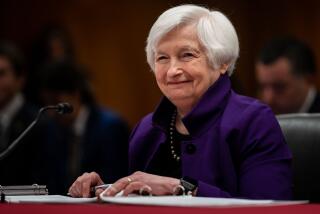Banks Offer $10 Billion to Gird Insurance Fund : Finance: But a provision of the proposal is that the fund no longer be used to protect uninsured depositors.
- Share via
WASHINGTON — The banking industry said Tuesday that it can offer $10 billion to bolster the federal insurance fund for savings, but it wants the taxpayers to bear the burden of any future rescues of big, uninsured depositors.
“We want a healthy insurance fund as well as a healthy banking industry,” Eugene Miller, president of the Assn. of Bank Holding Companies, told a news conference called to formally present the industry plan.
The existence of the plan was first disclosed Sunday.
Banks would provide additional cash for the fund by purchasing special bonds issued “as needed” by the Federal Deposit Insurance Corp., five industry trade groups said in a letter to FDIC Chairman L. William Seidman.
But one provision of the plan will prove highly controversial: the bankers’ insistence that “under no circumstances” should the fund be used to protect uninsured depositors, those with more than $100,000 in a single account.
In the recent Bank of New England failure, federal regulators decided to use the fund to guarantee $2.3 billion in uninsured deposits to avoid economic trauma in the region.
The bankers say this responsibility of safeguarding the general economic welfare in the event of bank failure should be shifted “elsewhere,” as in the federal bailouts of Chrysler, Lockheed and New York City. “Elsewhere” means the taxpayers, who bore the ultimate risk of those earlier fiscal rescue efforts.
“Simply putting more money into the fund is not the ultimate solution,” said Richard A. Kirk, chairman of the American Bankers Assn. “The bank insurance fund has become a safe haven for big depositors at the nation’s largest institutions. Uninsured depositors and uninsured creditors have been inappropriately sheltered by the ‘too-big-to-fail’ concept,” the bank groups said.
Initial congressional reaction was skeptical Tuesday.
The bankers’ plan is a “make-do effort, an attempt to slide by until the problems get worse,” said Rep. Bruce Vento (D-Minn.), a member of the House Banking Committee.
“The fund needs real money--if the banks have a lot of capital, as they claim, they should offer to use it for the fund,” Vento said.
FDIC Chairman Seidman, who has given his general approval to the industry plan, could issue the bonds proposed by the banking industry without specific congressional approval--the FDIC has approximately $60 billion in potential borrowing authority.
The bonds would be repaid through a special assessment on the industry, in addition to the regular premiums banks pay into the fund. “Our associations would commit to work with bankers throughout the country to purchase these bonds,” the industry trade groups said in the letter to Seidman.
Some key portions of the industry plan would require legislation, such as the creation of a $2-billion fund to pump money into weak banks to strengthen them until mergers can be arranged with sound institutions. The bankers want the $2 billion to come from the $18 billion in non-interest-bearing bank reserves held in the Federal Reserve system.
Schumer said that proposal will “face very tough sledding.” The $2 billion is already included in the federal budget, and any use of it for other purposes would worsen the deficit, he noted.
The bankers and Seidman agree that $10 billion from the industry, plus $5 billion available to the FDIC from a Treasury line of credit, should be enough to keep the fund solvent in the face of increasing bank failures this year and in 1992.
More to Read
Inside the business of entertainment
The Wide Shot brings you news, analysis and insights on everything from streaming wars to production — and what it all means for the future.
You may occasionally receive promotional content from the Los Angeles Times.










